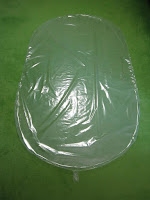Time: 07:00 GMT (09:00 CEST)
Place: Roznov pod Radhostem, CZ
Tracking: http://aprs.fi
| Transmissions | ||
|---|---|---|
| Type | APRS | |
| Callsign | OK7DMT-2 | |
| Frequency | 144.39-145.57 | MHz |
| Period | 2 | min |
| Transmit Power | 12.5 | mW |
The packets are a combination of Base91 encoded position and custom telemetry data in the comment section of the packet. An online decoder and example packets can be found at this link. The tracker transmits on local APRS frequencies. In case of GPS failure, telemetry without position is transmitted. Packets also contain backlogged data from the past 7 days.
| Flight Parameters | ||
|---|---|---|
| Lifting Gas | hydrogen | |
| Envelope Volume | 1.045 | m3 |
| Envelope Mass | 224.0 | g |
| Payload Mass | 18.5 | g |
| Free Lift | 10.0 | g |
| Neck Lift | 28.5 | g |
| Initial Ascent Rate | 0.88 | m/s |
| Expected Float Altitude | 13810 | m |
The balloon on this flight was an obround shaped envelope 2.35m in length (flat) from a 40μm multilayer (PE/PA/EVOH/PA/PE) film. The making of the envelope is in detail described in this blog post. A calculator was used to obtain the flight parameters based on previously measured envelope volume, mass and payload mass. Latest atmospheric sounding data (Prostejov, 20190915 0:00Z) were used to calculate the expected float altitude.
Initial ascent trajectory was modeled with CUSF Landing Predictor, while the long term float predictions with HYSPLIT Trajectory Model. The HYSPLIT prediction contains three altitude levels. One 500m below and another 500m above the expected float altitude.
The design of the tracker is in detail described in this and this blog posts. The final touches consisted of securing an Energizer Ultimate Lithium AA primary battery this time (estimated lifetime ~60 days) to the tracker. The battery was covered in black electrical tape, and leads were soldered directly to the battery's terminals. For more images of an identical tracker construction, except for a smaller battery (AAA), see TT7B1.
A pressure sensor and a thermistor were sealed inside the envelope, and the gas inlet was glued shut. Two thin magnet wire antenna radials were fastened to the balloon's circumferential weld. The lead connecting the battery to the tracker was soldered just before the launch. After the bad experience with TT7B1, this launch took place a couple hours later in the day, and the balloon and mainly hydrogen were left in the sun for a while to warm up.
Day 1: The balloon ascended at an average rate of 1.0m/s (maximum 2.3m/s) to an initial altitude of 13500m. It flew over the countries of Slovakia, Hungary, Croatia and Slovenia, and was received by a large number of stations along its way. The satellite images didn't show any thunderstorms nor any other high altitude clouds in the area.
After the sunset, the temperature measured by the onboard thermistor fell down to -63°C. The GPS module was the first to experience difficulties. The average active time needed for a valid fix increased. At times, the module failed completely and most likely communication with the module timed out. The MS5607 barometric pressure sensors eventually failed as well and only returned to outputting reasonable readings after the balloon descended to warmer altitudes (warmer than -35°C). The tracker never stopped functioning completely. The MCU kept working even during the lowest ambient temperatures.
After a gradual decrease in altitude to 13000m during the evening and night, at 0:50 GMT the balloon began descending at an average rate of -1.3m/s (maximum -1.9m/s) and landed in Croatia.
The top two charts contain data from the whole flight. The bottom two charts show data only until a point the pressure sensors began outputting nonsensical data due to extremely low temperature. In the last chart, the measured temperatures and pressures were used to calculate the resultant force acting on the balloon ($F_{lift}-F_{weight}$) if it contained the same amount of hydrogen as it was filled with. The curve shows positive values during the balloon's climb to altitude, then values around zero when it started floating. However, later the values begin to rise again, while the balloon's altitude stays the same or even decreases suggesting the envelope was leaking hydrogen which eventually resulted in the balloon's descent to ground.
Update: TT7B2 was recovered by Kruno 9A3SWO in northern Croatia near the town of Krapina lying on a field as can be seen in the images he provided. Kruno was kind enough to send me the tracker back, so I will probably re-launch it under a new envelope.
All the received APRS packets can be found in this text file: TT7B2_packets.txt
And all the decoded live and backlogged data can be found in this csv file: TT7B2_data.csv


















No comments:
Post a Comment